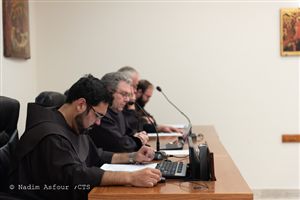The three-year formation at St. Savior’s Monastery in Jerusalem continues: on November 3, the Custodial Curia hosted a formative meeting addressed to the sacristans, sanctuary workers, spiritual pilgrimage leaders and to the Franciscan Pilgrimage Office.
A choral prayer of introduction guided those present in a reflection on the importance of their work in offering pilgrims an experience of simple faith. Br. Marcelo Ariel Cichinelli, who is in charge of Continuing Formation and who is the organizer of the meeting, recalled the central theme of “Service to the Shrines and Administration of Goods” in his introduction. A reflection on the main topic by the Father Custos of the Holy Land, Fr. Francesco Patton, followed.
Fr. Patton recalled the extraordinary nature of the Sanctuaries of the Holy Land. They, the Custos said, “are unique shrines linked to particular events or are built on the places mentioned in the Bible.” These are the places linked to the mystery of the Incarnation, such as Christ’s birth and the Annunciation, as well as to the places of Christ’s childhood and public life of preaching. One musn’t forget the Jerusalem area where there are the shrines linked to Holy Week and to the Paschal Mystery: from Jesus’ solemn entry into the city, to his Passion, Death and Resurrection, Ascension and gift of the Spirit.
The Custos has expressed three essential attitudes for the caring for the shrines, taking as an example St. Paul VI’s apostolic exhortation of “Nobis in Animo”: protecting, guarding and restoring. This, according to Fr. Patton, is the most appropriate way to serve the local Church and the Christian holy places. “We believe it is necessary,” he continued, “for our Sanctuaries to be guarded and protected from both bad weather and inconvenient conditions, given the new areas of need, it is also necessary for the Sanctuaries to be restored.” The restoration work and care for the places, he explained, are essential for highlighting those details that date back to past centuries and can be rediscovered, such as the Seventh Angel of Bethlehem which became visible again during the recent restoration work for example. This type of work aims to offer visitors an experience of the beauty of faith, and it is necessary for the places to be beautiful, faithful both to themselves and to the mystery they commemorate.
Two levels of significance were identified and placed at the attention of those working in the shrines: the local level, for the faithful who live nearby, and the global, for pilgrims and tourists who come from all over the world, many of whom are able to come to these places only once in their lives. “With the amount of pilgrims visiting, you have to have equipped facilities: for example we are working on the specific way of welcoming the disabled by adding ramps where possible, so that all pilgrims can pray, read the passages from the Gospel or other Biblical references and so that they can celebrate Holy Mass,” said the Custos. In fact, work continues on the infrastructure to guarantee sufficient water, restrooms and an essential a welcoming presence so that it is easier for pilgrims and locals to focus better on the experience of faith.
Source: Giovanni Malaspina






